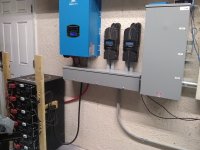kmakar
Janitor
We've been running our house "part time" on my self designed offgrid solar setup for about 2 years now and it's worked out well. We used the solar power during the day, and at night it switched back to line power (automatically). We cut our electric bill in half and at the same time had had full time power in the event of a power outage from the power company without the need of a generator.
With the cost of LifePO4 batteries (lithium iron phosphate) dropping considerably (we had been using sealed lead acid deep cycle batteries), we decided it was time to make the jump to the new LifePO4 batteries. We also decided that the current setup of using 2 decent sized inverters (one was 6,600 watts, and the other 6,000 watts) introduced additional hurdles to overcome (by splitting out our electrical panel to use the power of each inverter to split the load), so we also got a much larger inverter (18kw with a 30ms surge rating to 54kw).
We are still waiting on 2 more LifePO4 batteries (we currently have 600 amp hours, but are adding 2 more for a total of 800 amp hours). I finished the upgrade yesterday and after the batteries get their first full solar charge today, we'll be going full time solar (flipping the transfer switch to full time solar).
I still have to design, build, and weld a steel rack to house and protect the batteries, but I just held it together with wood for now.
I did all the electrical work myself. I used to be a general contractor, so for me it's rather simple.
Here is what our setup looks like.... I was testing the loads on the new inverter last night and everything performed perfectly.
If you have questions regarding offgrid solar, I'll do my best to answer questions or help.

With the cost of LifePO4 batteries (lithium iron phosphate) dropping considerably (we had been using sealed lead acid deep cycle batteries), we decided it was time to make the jump to the new LifePO4 batteries. We also decided that the current setup of using 2 decent sized inverters (one was 6,600 watts, and the other 6,000 watts) introduced additional hurdles to overcome (by splitting out our electrical panel to use the power of each inverter to split the load), so we also got a much larger inverter (18kw with a 30ms surge rating to 54kw).
We are still waiting on 2 more LifePO4 batteries (we currently have 600 amp hours, but are adding 2 more for a total of 800 amp hours). I finished the upgrade yesterday and after the batteries get their first full solar charge today, we'll be going full time solar (flipping the transfer switch to full time solar).
I still have to design, build, and weld a steel rack to house and protect the batteries, but I just held it together with wood for now.
I did all the electrical work myself. I used to be a general contractor, so for me it's rather simple.
Here is what our setup looks like.... I was testing the loads on the new inverter last night and everything performed perfectly.
If you have questions regarding offgrid solar, I'll do my best to answer questions or help.



